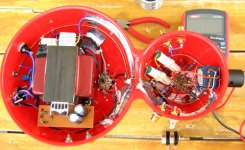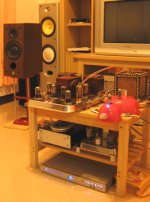Hello all,
I built the following M7 pre with very good results...It is paralleled and I used LED bias on the cathode. No smearing or focus issues on parallel setup as far as I can hear. The two sides in a 5687 should be close enough not to smear the focus...
Two Red LEDs for around 4v bias. I used 8.2K plate resistor. DC on heaters, and CLCR instead of the CRCR power filter. The L is a 10H choke.
If I recall correctly, around 250V B+ and 110V on plate, so 17ma per??
This thing really sounds nice. I am building a 6SN7/6SN7 Aikido and would be too surprised it I stay with the M7.
EDIT - oh, and instead of R22 resistor on PS filter, I had to use 220R to reduce hum...totally quiet now...
I built the following M7 pre with very good results...It is paralleled and I used LED bias on the cathode. No smearing or focus issues on parallel setup as far as I can hear. The two sides in a 5687 should be close enough not to smear the focus...
Two Red LEDs for around 4v bias. I used 8.2K plate resistor. DC on heaters, and CLCR instead of the CRCR power filter. The L is a 10H choke.
If I recall correctly, around 250V B+ and 110V on plate, so 17ma per??
This thing really sounds nice. I am building a 6SN7/6SN7 Aikido and would be too surprised it I stay with the M7.
EDIT - oh, and instead of R22 resistor on PS filter, I had to use 220R to reduce hum...totally quiet now...
Attachments
john65b said:Hello all,
I built the following M7
Nice, but why call it an M7? Your bias point is much closer to something "normal" than the AN.
Yes, I agree.
Is there one operating point that is optimum for a 5687? I like the one I have a lot. Seems more bias current yields better sound, just like class A SS amps, with guidlines and limits not exceeded that is. I have read Low mu tube, high current, high mu tube low current seems best.
And one more Q for you all. Paralleled tubes - the output impedance is halved? Gain doubled? I can see the smear issue, but both sides in a 5687 tube should be matched?
Is there one operating point that is optimum for a 5687? I like the one I have a lot. Seems more bias current yields better sound, just like class A SS amps, with guidlines and limits not exceeded that is. I have read Low mu tube, high current, high mu tube low current seems best.
And one more Q for you all. Paralleled tubes - the output impedance is halved? Gain doubled? I can see the smear issue, but both sides in a 5687 tube should be matched?
Lots of difficult questions. Apparently kor952 prefers the low bias point. It will probably have higher measurable distortion but be easier on the PS. Using a high quality PS, per example a superreg of some type, may produce a different result.
As for paralleling, i am not a big fan but in the context of a system it may work well. Whether it is a low voltage MC stage or a power amp, tube or solid state the effects are very similar - a bit less focus. Paralling also changes the tonal balance a bit, making the sound subjectively more solid and bassy and can be preferable in a "thin" sounding system.
Each tube should have a separate small cathode resistor for current sharing and a separate grid stopper. Ideally all sections should have matching characteristics around the operating point which is almost impossible to achieve.
Indeed, when paralleling two tubes Rp is halved and gm doubled.
As for paralleling, i am not a big fan but in the context of a system it may work well. Whether it is a low voltage MC stage or a power amp, tube or solid state the effects are very similar - a bit less focus. Paralling also changes the tonal balance a bit, making the sound subjectively more solid and bassy and can be preferable in a "thin" sounding system.
Each tube should have a separate small cathode resistor for current sharing and a separate grid stopper. Ideally all sections should have matching characteristics around the operating point which is almost impossible to achieve.
Indeed, when paralleling two tubes Rp is halved and gm doubled.
I can see the smear issue
Good. Please explain it to me because I can't figure out what that could possibly mean.
analog_sa said:
Indeed, when paralleling two tubes Rp is halved and gm doubled.
You're right but I wouldn't call Gm the Gain but the transconductance, gain imho is dependent on the amplification factor wich will NOT change by paralleling tubes.
Everyone who's straight thinking about designing a preamp never would come up with a design as the Kondo M77, but just read the articles where the preamp is tested, and you know it is one of the best if not the very best preamp around.
anyone know the B+ voltage for the 6072 version?
cheers
I think it's between 230 and 245V, depending on the version (M7 tube, line, phono). The secondairy on the mains transformer is 250-0-250V 100mA.
I think it's between 230 and 245V, depending on the version (M7 tube, line, phono). The secondairy on the mains transformer is 250-0-250V 100mA.
Thanks Kor
Hello! Every one, ( and sawad-dee krub K.bee696 )
My project of Audionote M7 -->àÊÃç¨áÅéǤÃѺ Audionote M7 Project: á·è¹»ÃÕáÍÁ»ì¨Ò¡¶éÇÂàÁÅÒÁÕ¹
The sound so good good , but I reccomment Paper oil coupling CAP for sweet sound !!!!!
thank you[image][/image]
My project of Audionote M7 -->àÊÃç¨áÅéǤÃѺ Audionote M7 Project: á·è¹»ÃÕáÍÁ»ì¨Ò¡¶éÇÂàÁÅÒÁÕ¹
The sound so good good , but I reccomment Paper oil coupling CAP for sweet sound !!!!!
thank you[image][/image]
Attachments
Dear all,
I'm so confused !
Which one is the most update schemtic for M7/M77 ?
What is the "Tube" using now ?
What is the year of the attached one ?
Many Thanks !
This schematic is from early '90.
For the line part the M77 uses the same schematic but doubles the tubes (parallel). Even the recently introduced Kondo G70 line preamp uses the same schematic with slightly different values. Just built and try, the better the parts the better the sound, but be aware of the high gain (20x or more).
Ronald.
This schematic is from early '90.
For the line part the M77 uses the same schematic but doubles the tubes (parallel). Even the recently introduced Kondo G70 line preamp uses the same schematic with slightly different values. Just built and try, the better the parts the better the sound, but be aware of the high gain (20x or more).
Ronald.
Thanks !
Do you the update schematic ? What is the values of the Resistors after parallel ?
What are the tubes they are using now ?This schematic is from early '90.
For the line part the M77 uses the same schematic but doubles the tubes (parallel). Even the recently introduced Kondo G70 line preamp uses the same schematic with slightly different values. Just built and try, the better the parts the better the sound, but be aware of the high gain (20x or more).
Ronald.
Thanks !
Do you the update schematic ? What is the values of the Resistors after parallel ?
I do not have a schematic of the M77. The resistor values are the same as the M7 so not devided by 2.
Ronald.
I do not have a schematic of the M77. The resistor values are the same as the M7 so not devided by 2.
Ronald.
Sorry for the late, late reply !
Do you mean just parallel the two tubes, but not change the resistor's vales , why ?
I have read the schematic of Matisse Reference and Fantasy( parallel the two tubes), they devided resistor's vales by 2 !
Thanks !
Sorry for the late, late reply !
Do you mean just parallel the two tubes, but not change the resistor's vales , why ?
I have read the schematic of Matisse Reference and Fantasy( parallel the two tubes), they devided resistor's vales by 2 !
Thanks !
The only thing I can think of why the tubes are parallel.... less current is less noise.
I am certain the resistor values are the same as in the M7 so not devided by 2.
Ronald.
Hello all,
I built the following M7 pre with very good results...It is paralleled and I used LED bias on the cathode. No smearing or focus issues on parallel setup as far as I can hear. The two sides in a 5687 should be close enough not to smear the focus...
Two Red LEDs for around 4v bias. I used 8.2K plate resistor. DC on heaters, and CLCR instead of the CRCR power filter. The L is a 10H choke.
If I recall correctly, around 250V B+ and 110V on plate, so 17ma per??
This thing really sounds nice. I am building a 6SN7/6SN7 Aikido and would be too surprised it I stay with the M7.
EDIT - oh, and instead of R22 resistor on PS filter, I had to use 220R to reduce hum...totally quiet now...
I have finally got round to trying to solve the hum issue on my M7 build which has DC heaters. This post talks about a R22 resistor on the PS Filter being changed to a 220R to solve the hum issue but upon opening the schematic, I cant see any R22 resistors. Which resistor has been changed to relieve hum? Can anybody help?
Aaahh.....got it! I have a CLCR supply in mine too and I think I needed to use a much higher value than 220R to get the right anode voltage of around 250V. I have used DC heaters, lifted earth via a resistor, added capacitance and just can't seem to get rid of the hum. The hum becomes instrusive at about 65% volume on my power amp and seems to be independant of the volume setting on the pre. Any suggestions as to what else I could try?
- Home
- Amplifiers
- Tubes / Valves
- Audio Note M7 Line Preamp??

